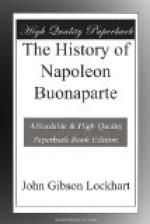Having melted the poor relics of his Moscow army into these battalions, Napoleon now continued his march on Studzianska; employing, however, all his wit to confirm Tchichagoff in the notion that he meant to pass the Beresina at a different place,—and this with so much success, that Tchaplitz, with the Russian rear-guard, abandoned a strong position, commanding the river, during the very night which preceded his appearance there. Two bridges were erected, and Oudinot had passed over before Tchaplitz perceived his mistake, and returned again toward Studzianska.
Discovering that the passage had already begun, and that in consequence of the narrowness of the only two bridges, it must needs proceed slowly, Tchichagoff and Witgenstein now arranged a joint plan of attack. The latter once more passed to the eastern bank of the river, and, having wholly cut off one division of 7000, under Partonneux, not far from Borizoff, proceeded towards Studzianska. Platoff and his indefatigable Cossacks joined Witgenstein on this march, and they arrived long before the rear-guard of Napoleon could pass the river. But the operations on the other side of the Beresina were far less zealously or skilfully conducted. Tchichagoff was in vain urged to support effectually Tchaplitz; who attacked the French that had passed, and being repelled by Oudinot, left them in unmolested possession, not only of the bridges on the Beresina, but of a long train of wooden causeways, extending for miles beyond the river, over deep and dangerous morasses, and which being composed of old dry timber, would have required, says Segur, “to destroy them utterly, but a few sparks from the Cossacks’ tobacco pipes.”
In spite of this neglect, and of the altogether extraordinary conduct of Kutusoff, who still persisted in marching on a line parallel with Napoleon, and refusing to hazard any more assaults, the passage of the Beresina was one of the most fearful scenes recorded in the annals of war. Victor, with the rear-division, consisting of 8000 men, was still on the eastern side—when Witgenstein and Platoff appeared on the heights above. The still numerous retainers of the camp, crowds of sick, wounded, and women, and the greater part of the artillery, were in the same situation. When the Russian cannon began to open upon this multitude, crammed together near the bank, and each anxiously expecting the turn to pass, a shriek of utter terror ran through them, and men, women, horses, and waggons rushed at once, pell-mell, upon the bridges. The larger of these, intended solely for waggons and cannon, ere long broke down, precipitating all that were upon it into the dark and half-frozen stream. The scream that rose at this moment, says one that heard it, “did not leave my ears for weeks; it was heard clear and loud over the hurrahs of the Cossacks, and all the roar of artillery.” The remaining bridge was now the only resource, and all indiscriminately endeavoured to gain a footing on it. Squeezed,




